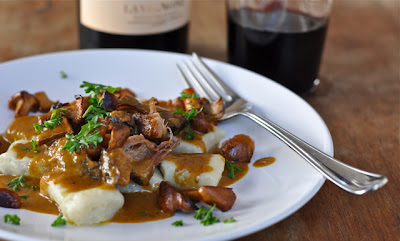 THE FIRST CHANTERELLES of the season are always my favorite. They’re firm and flavorful, without the large, tattered caps that are typical later in the season after multiple rain soakings.
THE FIRST CHANTERELLES of the season are always my favorite. They’re firm and flavorful, without the large, tattered caps that are typical later in the season after multiple rain soakings.1 veal shank section, about 1 1/2 lbs
salt and pepper
2 tbsp olive oil
1 tbsp butter, divided
1/2 onion, chopped
1 carrot, chopped
1 stalk celery, chopped
2 cloves garlic, peeled and crushed
1 bay leaf
1 tsp dried thyme
1/4 tsp saffron threads
1 heaping tsp tomato paste
1/2 cup white wine
1 cup veal stock
1/4 cup heavy cream
1/2 lb chanterelle buttons, halved
parsley for garnish
1. Pre-heat oven to 300 degrees. Pat dry shank and season with salt and pepper. In a large, heavy casserole or dutch oven, brown the shank in 1 tbsp olive oil and half the butter over medium-high heat.
2. Remove shank and add remaining 1 tbsp olive oil along with onion, carrot, and celery. Cook until softened over medium heat, about 10 minutes. Add the garlic, thyme, saffron, and tomato paste, stir, and cook for a couple minutes.
3. De-glaze with white wine. Add the stock (I used Demi-Glace Gold from a package). Return the veal shank to pan with any juices, cover, and cook in oven for 1 hour. Turn shank, cover, and cook for another hour. Uncover and cook for final 30 minutes or so, until meat is tender and almost falling off the bone. Add water to braising liquid if necessary at any point while it’s cooking in the oven. When done, transfer shank to a plate and cover loosely with aluminum foil.
4. Strain braising liquid through a sieve, making sure to press vegetables to extract juice. Reduce liquid in a saucepan to 3/4 cup. Stir in cream and check seasoning.
5. Meanwhile, saute chanterelles in remaining butter over medium-high heat.
I plated the veal shank over home-made gnocchi, scattered the chanterelles around the plate, and finished it with a generous pour of sauce and a sprinkling of chopped parsley.
























